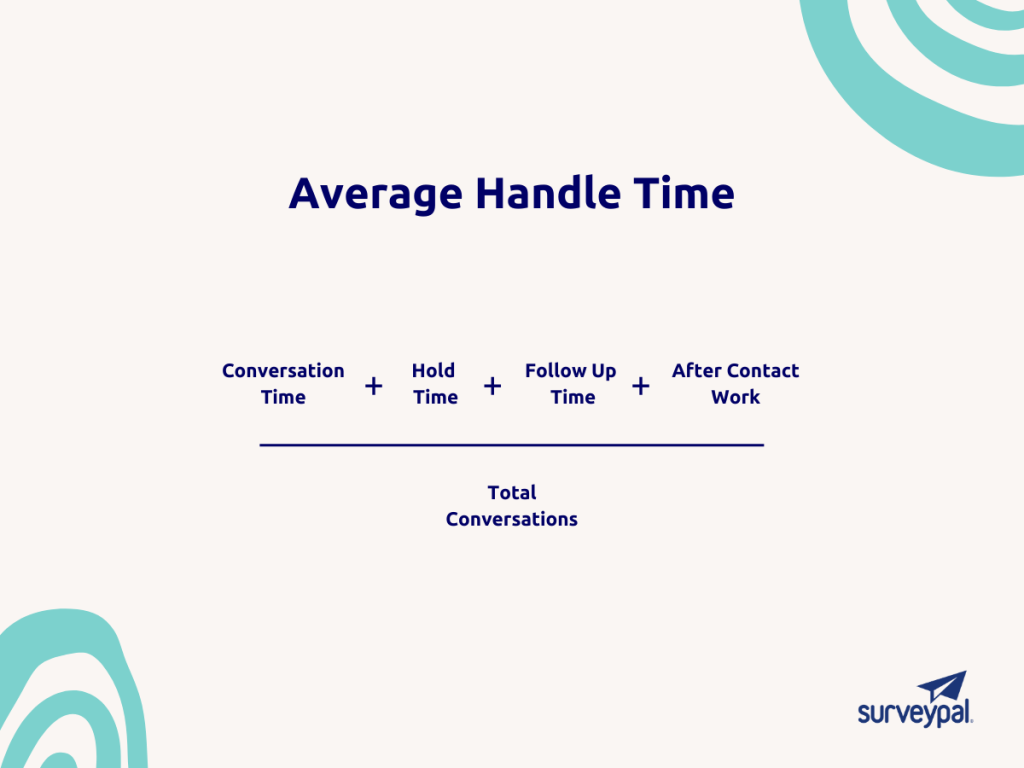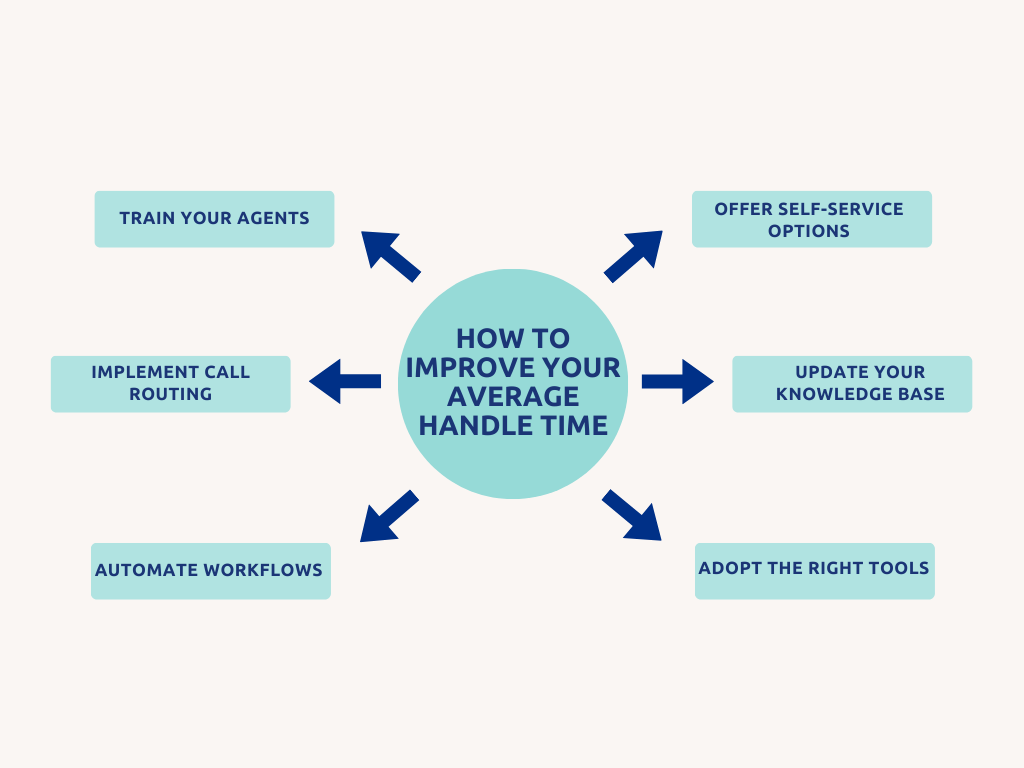The Average Handle Time is a critical metric in the contact center industry that measures the average time it takes for an agent to handle a customer interaction, including talk time and any post-call work.
AHT is a vital indicator of help center efficiency and can affect customer satisfaction, agent performance, and overall business profitability. In this post, we will explore what AHT is, why it matters, how it is calculated, and some tips on how to optimize it. Whether you are a contact center manager, agent, or simply interested in learning more about key customer service metrics, this post will provide valuable insights and practical advice to help you better understand and manage AHT.
What is Average Handle Time?
Average Handle Time (AHT) measures the time required for a customer support team to respond to their customers on average. If used correctly, AHT can give lucrative outcomes because it helps professionals and managers measure customer service performance on immediate support channels such as live chats and calls. Moreover, businesses can use these metrics to measure the effectiveness of non-immediate channels such as emails. The data points to measure average handle time include:
- Talk time
- Hold time
- Call initiation
- After call work
The AHT revolves around the concept that you can make your customers happy by quickly responding to and resolving their queries.
The Importance of Average Handle Time
The Average Handle Time is crucial since it’s a great indicator for assessing the efficiency of your contact center and its general level of client satisfaction.
Here are the top reasons why your Average Handle Time matters so much:
- Higher Customer Retention Rates
- Increased Customer Service Productivity
- Improved Customer Satisfaction
- Opportunities for Upselling, Cross-selling, and Positive Word-of-Mouth
- Reduced Customer Service Costs
Higher Customer Retention Rates
Optimizing ticket handling times is more about providing an incredible experience and encouraging people to return to your business than answering calls more quickly.
Recurring customers increase your business value by 1,000% throughout their lifetime, according to 61% of SMBs, who report that more than half of their revenue originates from them. It doesn’t matter how much money you spend acquiring new clients; you will still lose them with a high churn rate.
Conversely, cutting churn by 5% can boost sales at your business by 75%.
Increased Customer Service Productivity
You can reduce time-consuming tasks like call transfers and hold times by determining the appropriate AHT for your business. The operational performance increases when bottlenecks in the workflow process are removed, allowing your agent to handle more calls.
Want to learn other techniques to improve customer service productivity? Here are tips for you.
Improved Customer Satisfaction
According to a 2021 TCN poll, 59% of customers claim that their top gripe with call centers is that they waste their time waiting for a response. It’s interesting to note that long average handle times make customers feel worse than not having their problems fixed.
According to Ifbyphone research, 15% of callers hang up after 40 seconds of speaking with a customer support representative. According to a TCN study from 2021, 34% of callers hang up after a maximum of 6 minutes on hold, while 26% do so after 2-4 minutes.
Based on the above, it is easy to discern the correlation between AHT and customer satisfaction. Additionally, when you are able to look at your data and determine your optimal average handle time you will be able to provide your agents with a stronger framework of dos and don’ts to manage customer requests more successfully.
More Opportunities for Upselling, Cross-selling, and Positive Word-of-Mouth
72% of customers tell six or more friends about their excellent brand experiences, according to research by customer success specialist Esteban Kolsky. Conversely, 13% of your unhappy clients will go out of their way to discourage 15 additional prospective clients from doing business with you.
Happy customers who experienced speedy resolutions can share their positive experiences others thus creating positive word of mouth.
Additionally, customers who receive qualitative support are more willing to consider buying more products or services from your business.
Reduced Customer Service Costs
Any attempt to optimize your Average Handle Time will immediately impact your overall customer service costs. The less time your agents spend handling requests, the lower your costs for providing support. The real challenge in reducing your AHT is ensuring you don’t compromise service quality while doing so.
How to Calculate the Average Handle Time
You can calculate your Average Handle Time with various formulas. But, the most effective technique is using the three building blocks. The three building blocks of AHT include conversation time, hold time, follow-up time and any additional work required after the end of the support interaction.
The Building Blocks of Average Handle Time
Let’s take a closer look at the building blocks of the Average Handle Time:
- Conversation Time: The duration of each support request that your agents take is a simple piece of information to get. Include any interactive time when clients are entering data into a computerized system.
- Hold Time: This figure should be straightforward to collect once more and is even more limited than conversation time.
- Follow-Up Time: Follow-up time refers to the length of time it takes for a customer service agent to respond to a customer’s inquiry, request, or complaint after the initial contact has been made. Follow-up time can vary depending on the nature and urgency of the customer’s issue, as well as the company’s policies and procedures for responding to customer inquiries.
- After Contact Work: After contact work refers to the tasks that the customer service representative performs after completing a customer interaction such as updating customer records, creating a summary of the interaction, scheduling follow-up tasks or appointments, sending out emails or other communications, and documenting any relevant information related to the interaction.
Average Handle Time Formula
Here is the formula to determine the average handle time for your business:

What is a Good Average Handle Time?
Leaders should use AHT to improve their processes rather than utilize it as a standalone service metric. For instance, regularly publishing in-depth articles on a knowledge base can reduce long call times.
Use a formula compatible with contact center industry best practices as your company examines AHT more closely.
You can use information from Talkdesk’s KPI Benchmarking Report released in 2021 to determine industry averages. However, it’s crucial to remember that the report doesn’t include follow-up time and cannot be factored into the calculation.
The average handle time split by the typical hold time is displayed per industry in the table below.
| Industry | Average Handle Time |
|---|---|
| Finance | 4 minutes and 5 seconds |
| Professional Services | 3 minutes and 36 seconds |
| Healthcare | 3 minutes and 28 seconds |
| Manufacturing | 4 minutes and 13 seconds |
| Retail and eCommerce | 3 minutes and 29 seconds |
| Telecom | 2 minutes and 36 seconds |
| Media and Communication | 3 minutes and 30 seconds |
| Transportation | 4 minutes and 8 seconds |
The handle time for all of these services is 3.63 minutes on average.
You can only come up with a good number when you combine your AHT data with metrics such as the Customer Satisfaction (CSAT) or the Net Promoter® Score(NPS). NPS gauges how likely customers are to endorse your product or service. CSAT gauges a customer’s level of satisfaction with a given good or service. By examining the correlation between AHT and CSAT or NPS, you can improve productivity and grow customer retention.
How to Improve Average Handle Time?
Follow these strategies if you are looking for techniques to improve your Average Handle Time:

Train Your Agents
What does a new agent do during their first week on the job? You risk damaging your reputation immediately if they merely receive general company training.
Thanks to specialized agent coaching and training, you can customize your customer support function around particular inbound queries or customer segments. Make a list of all your products and market sectors, and then note how many of your employees have expertise in each. Do a gap analysis next to determine which areas require greater resources.
This method of training agents enables you to implement skills-based call routing for your queues. Clients then select their topic and are directed to the most qualified agent to address their problem.
Offer Self-Service Options to Deflect Incoming Contact Requests
You can deflect incoming calls by diverting customers to a self-service portal, such as a chatbot or a knowledge base. You can additionally divert the call to the right call agent according to their expertise through call answering machines. You can segregate the nature of the queries into different numbers. When the customers dial that number from their keypad, the answering machine will divert them to the right agent.
Implement Call-Routing Strategies
Ensuring that a consumer is immediately connected to the appropriate employee can decrease the average handling time in your call center.
For instance, you can direct a call from a consumer who needs a specific service to agents who are knowledgeable about it.
The routing procedure in a contact center should be fine-tuned to improve agent productivity and the client experience. Your teams can save productive time with shorter transfers or average call times. You can communicate with your customers on different channels using an omnichannel contact center.
Keep Your Internal Knowledge Base Up to Date
A knowledge base is a central repository for data that any employee in your company can use. It could include user-friendly FAQs, decision trees, visual aids, and movies. Well-informed agents can quickly provide the best answers.
Contact center agents won’t waste time looking for the necessary information because it is available on demand in the knowledge base. The centralized database and self-service tools shorten typical handle times and boost productivity.
Automate Workflows
Spending time directing consumers to the appropriate department may account for some of your prolonged interaction times. The average handling time for your customer may increase by needless minutes due to this overhead.
While it’s simple to point the finger at a client for making the wrong choice, solutions like interactive voice response (IVR) allow users to make the proper choice and avoid needless call transfers.
“Short call outliers” may also be present in your AHT. Customers who call in with these questions should expect a brief answer quickly. Consider including information about company hours and how to pay invoices in your IVR.
Empower Your Agents with the Right Customer Service Tools
Your team needs access to the best customer support tools for flawless customer service delivery.
When you provide customer support through many channels and with various tools, you invite delays and inefficiencies that negatively influence your average handling time.
For instance, you can reduce average handling time by incorporating tools that generate customers’ information. When agents have customer data and information, they can stop wasting their time by asking about their names and other information. Some tools save information on recurring customers, allowing agents to add the query to the system directly. Moreover, agents can check the address and contact details of the customers, saving them a huge time.
Agents can achieve speedy and first-contact resolution using real-time and historical customer data. Moreover, they can improve the reputation of the company.
Speed vs. Quality: The AHT Dilemma
Although reducing AHT benefits businesses, many companies ignore customer satisfaction. They focus on reducing the agent’s time to respond to the customers. But it results in poor support quality. As a result, agents cannot respond to customers properly.
Here are some ways to reduce AHT while maintaining the quality of each call:
Identify the Root Causes that Impact Your AHT
With 100% call coverage, the root reason for extended AHT can be found. Make sure to keep an eye on every exchange. Use speech analytics to discover frequent observable elements that affect AHT, such as hold-time violations, supervisor escalations, and dead air.
Sentiment analysis may occasionally enable you to identify typical client trouble issues. The call script for your agent can then be modified, or you can develop special standard operating procedures (SOPs) to deal with difficult callers and circumstances.
Businesses can find manageable solutions to large challenges using customer analytics.
Analytics decodes customer behavior, and this aids businesses in making wiser choices on management, pricing, and promotion.
According to McKinsey, companies that use customer analytics are 2.6 times more likely to have a significantly higher ROI and 3 times more likely to experience above-average sales growth than their rivals.
Consider AHT in Conjunction with Other KPIs
The difference between decreasing average handle time and increasing average handle time is significant. While a call center might make compromises to lower AHT, such as rushing consumers off the phone regardless of whether their issues are fixed, this would result in unhappy customers and other deteriorating call center performance metrics.
Offer Proactive Support
Any effective customer service plan must include proactive support since it allows you to give targeted, individualized support in advance using messenger-based channels. You can give clients the assistance they require before they contact your team by utilizing innovative tools like outbound messaging, advertising, product tours, and more.
Proactive support is an effective strategy to identify customers’ demands and offer relevant information saving a significant amount of agents’ time. You can use mobile forms and automation tools to identify problems and offer proper solutions.
Wrapping Up
A crucial indicator of contact center productivity, the average handle time reflects your team’s effectiveness. Lowering your AHT will increase customer satisfaction and agent performance immediately. Using the proper techniques, you can compute AHT automatically, assisting administrators, supervisors, and agents in receiving accurate reports without worrying about keeping track of time.
Did you like the post?
You might also like:

Surveypal
Everything you need to lead and improve your customer experience. Learn more at surveypal.com, or







